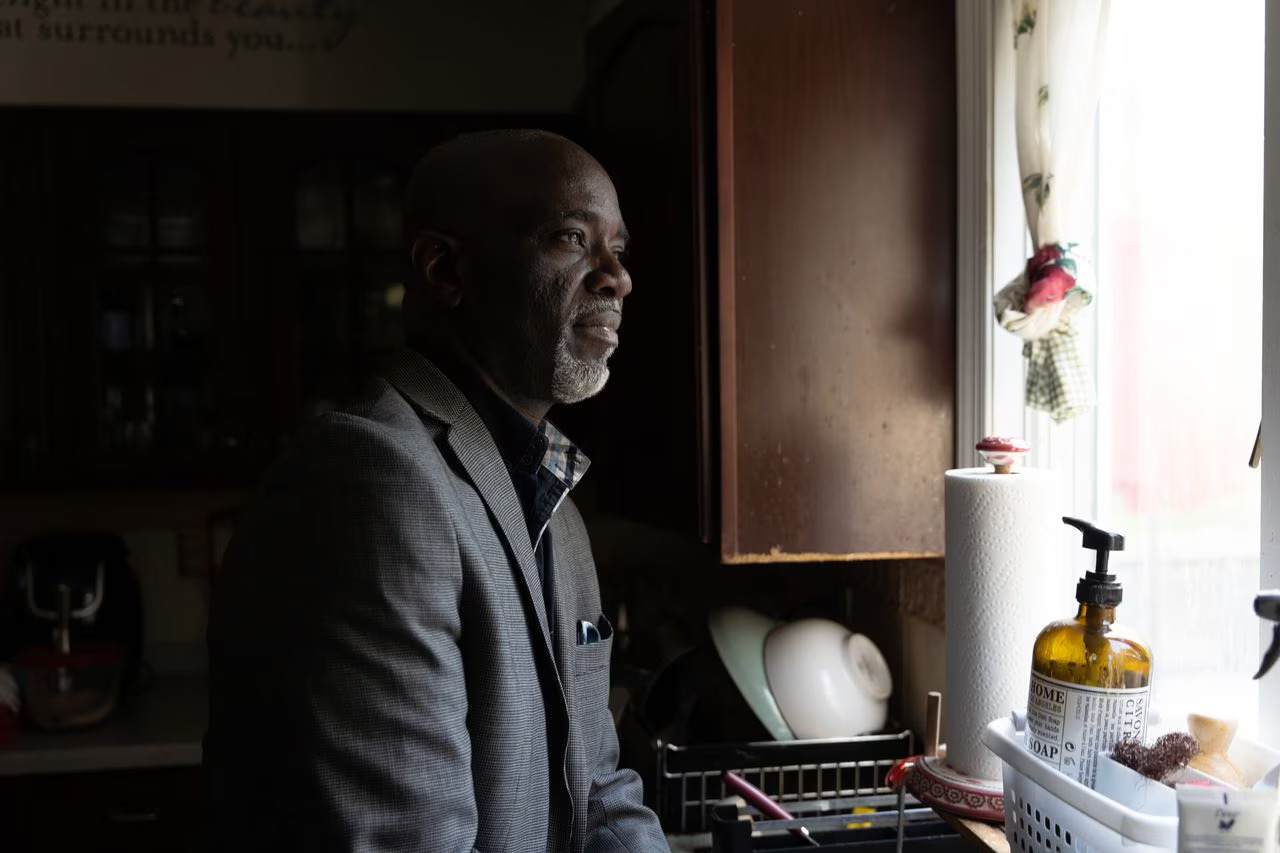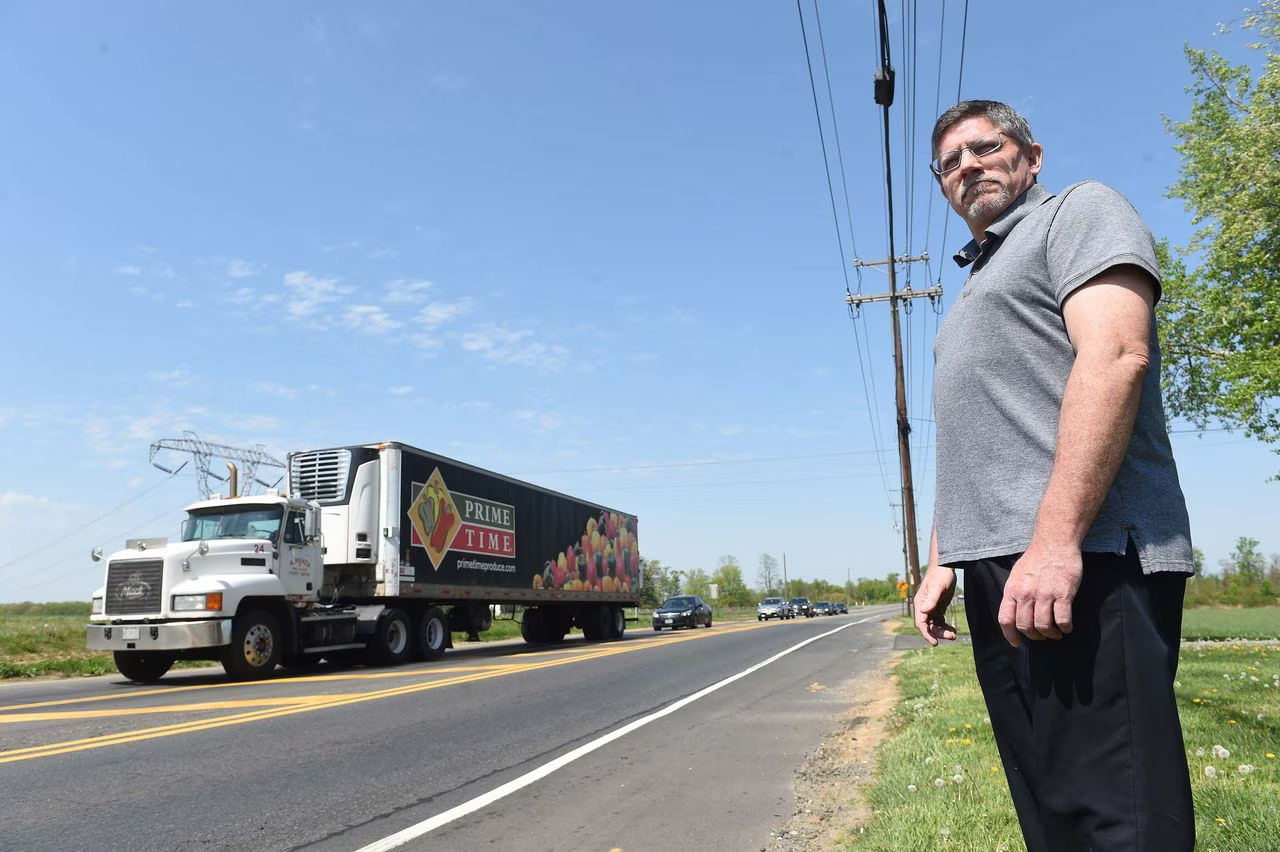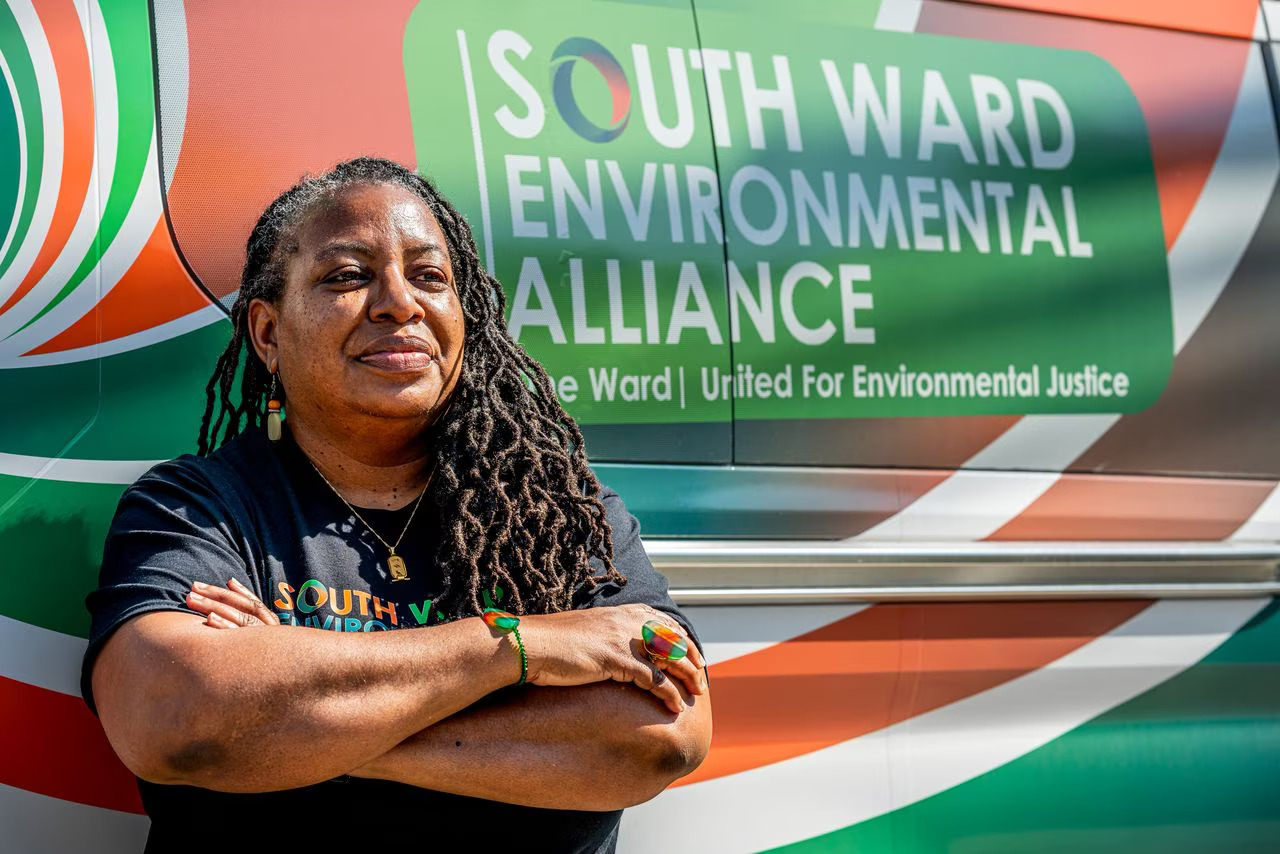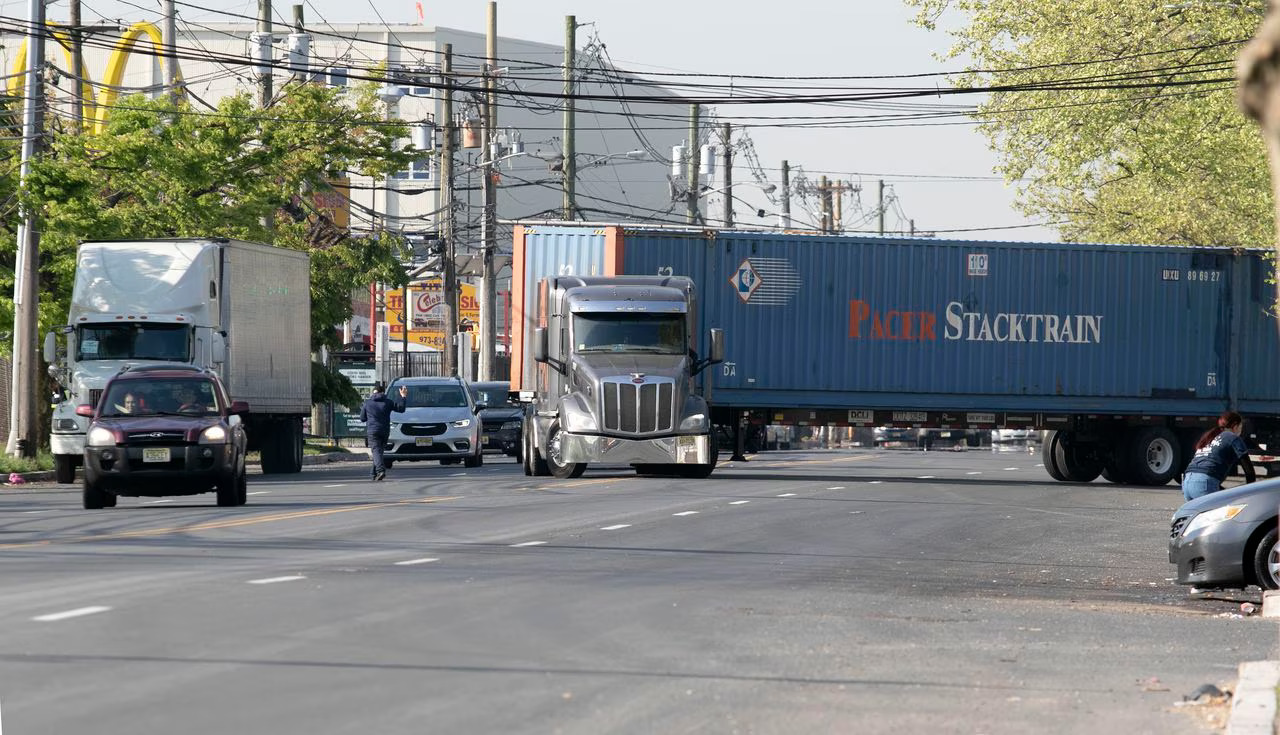

Dr. Adebambo Olajitan lives within 150 feet of a 60,000-square-foot warehouse and manufacturing facility operated by Agilex Fragrances in Franklin Township, Somerset County. Julian Leshay | For NJ Advance Media
By Jackie Roman | NJ Advance Media for NJ.com
This story was produced in collaboration with CivicStory as part of the New Jersey Sustainability Reporting project.
When James Kolpack started looking for a new home in New Jersey last year, he said he was searching for an area surrounded by farmland and “open space, where I would be able to relax a little.”
He settled on sprawling Mansfield Township in Burlington County, where the population of 8,897 is spread across 23 square miles. He picked a house down the road from a sleepy subdivision called Country Walk, near a 2.2 mile nature trail and a farm. It seemed like a good fit.
Instead, it’s been “a complete nightmare” all hours of the day and night, Kolpack said.
“Literally, the windows shake, the house starts to shake,” he said. “It’s the trucks.”
Mansfield — which includes Interstate 295 and several other major highways — has become a hotbed for warehouse development in recent years, like many other rural and suburban communities across New Jersey.
Eight new warehouses with a combined total of nearly 5.1 million square feet had already been approved for construction before Mansfield residents successfully fought for the township to pass an ordinance last year to prohibit any more warehouse development.
“They finished two other warehouses since I’ve been here, and there’s more coming,” Kolpack said. “Since we’ve been here, the truck traffic has quadrupled. And I mean, bigger, faster, louder.”
The rumble of trucks past Kolpack’s house is the soundtrack of warehouse development for many in New Jersey. And it’s something more residents will be hearing, seeing and feeling as the state continues to be the target of developers looking to build additional warehouses near New Jersey’s highways and ports.
The construction boom has drawn protests from some environmental and community organizations. But, warehouse and trucking industry groups say they are following state and local laws, in addition to working on making warehouses more environmentally friendly.

Mansfield Township resident James Kolpack has been complaining to local, county and state officials for months about the constant hum of trucks heading to and from warehouses near his Columbus Road home.
Some industry watchers say the demand for warehouse space in New Jersey may be waning. Amazon, the world’s biggest retailer, said last year it would shrink warehouse space in New Jersey after nearly a decade of expansion. And in many communities, newly built warehouses have not found tenants or are partially used.
However, development appears to be continuing unabated. A 2021 report from CoStar, a commercial real estate firm, said New Jersey was due to build more than 100 warehouses totaling 26.5 million square feet between 2021 and 2024.
New Jersey seems to be on track to hit that projection, said Anne Strauss-Wieder, director of freight planning for the North Jersey Transportation Planning Authority.
“It looks like we added 80 million square feet since 2017,” Strauss-Wieder said.
With more than 1 billion square feet of warehouse space, the state continues to be one of the top states in the nation for warehouses, according to industry reports. And that means more New Jersey residents are finding themselves living next door to warehouses and everything that comes with them.
‘I feel like I’m living in a truck stop’
While many residents living near warehouses have complained about increased traffic and noise, some say living near warehouses also comes with new smells.
When Dr. Adebambo Olajitan isn’t shutting the windows of his Franklin Township home to block out the sound of tractor-trailer trucks, he’s shutting them to seal out noxious fumes emanating from the nearby Agilex Fragrances warehouse and manufacturing facility.
“It’s very concerning,” said Olajitan, a pulmonologist. “This is a company that really shouldn’t be this close to where people live.”
“One of the reasons why we moved here was the quiet, serene atmosphere that we saw and that was the reason why we bought the house on a nice, quiet cul-de-sac,” he continued. “And to have it pretty much turn into a truck stop now, it’s ridiculous.”
Franklin Township is a sprawling community that spans 46 square miles in the Raritan Valley in Somerset County. Residents say its known for its “cornfields and kids,” and that’s exactly why Olajitan wanted to raise his family in the suburb.
But lately, Franklin Township has become known for a flurry of warehouse development. There is a total of 7.9 million square feet of warehouse space built, waiting to be built or waiting to be approved in the township, according to municipal data.
Olajitan lives less than 150 feet from the 60,000-square-foot warehouse where Agilex has been manufacturing and warehousing fragrances since 2017.
Since it opened, there have been more than 115 citizen complaints filed with the state Department of Environmental Protection about noxious chemical odors permeating the area, according to a civil lawsuit against Agilex and the DEP brought by Olajitan and five neighbors.
The state issued 25 violations of the state Air Pollution Control Act to Agilex between September 2019 and February because of the alleged release of odors at its Franklin Township facility, according to DEP spokesman Vincent Grassi.
Agilex has been assessed $90,625 in penalties and paid the majority of those fines, with the exception of $21,000 due this month, Grassi said. The company was also asked to pay $24,000 to the state’s It Pays to Plug In program to finance the installation of two electric vehicle charging stations at Inman Park in Franklin Township.

Thomas Del Casale says he rarely uses his backyard in Franklin Township due to the smell of noxious odors coming from the nearby Agilex Fragrances warehouse and manufacturing facility near his home.Julian Leshay | For NJ Advance Media
The fragrance company received a draft permit in December for the construction and installation of custom designed odor control equipment, said Bonnie Barnett, an attorney representing Agilex in legal proceedings.
“Agilex continues to work on obtaining approvals from other agencies so that it can construct, install, and operate this control equipment as soon as technically feasible and appreciates NJDEP’s efforts and assistance throughout this process,” Barnett said.
In the meantime, Agilex continues to release noxious odors, residents say.
“We haven’t had our windows open since July 2017. It’s pretty pathetic,” said resident Thomas Del Casale, one of the plaintiffs in the pending lawsuit against Agilex and the state Department of Environmental Protection.
“I have a beautiful wooded landscaped piece of property with a beautiful pool and a gazebo in the backyard, but most of the time we’re afraid to use it,” Del Casale said.
“Our quality of life has been completely diminished,” Del Casale said.
Warehouse development comes for the suburbs
New Jersey’s transportation, distribution and logistics industry has been a major economic driver for the state dating back centuries.
“New Jersey, even going back to colonial times and Alexander Hamilton has been a production and distribution platform for the nation,” said Strauss-Wieder, director of freight planning for the North Jersey Transportation Planning Authority.
Centrally located near the major cities of New York City, Philadelphia, Baltimore and Washington, D.C., New Jersey is within a 24-hour drive of nearly 40% of the nation’s population, according to Moody’s Analytics, an economic research firm.
New Jersey is also home to the largest port on the East Coast and the second largest in the nation, said Strauss-Wieder.
The growing need for delivery in the booming e-commerce industry, particularly during the COVID-19 pandemic, has fueled the expansion of warehouse development in New Jersey.
People who have an issue with driving past a growing number of trucks on the New Jersey Turnpike might forget that if they ordered something online this morning and it’s on their doorstep by this afternoon, it’s because a truck brought it to them, said Ted Ritter, the North Jersey Transportation Planning Authority’s manager of external affairs.
“So, it’s a challenge to make all these things work together and make these pieces go together. But, when it does, it’s a prosperous future for everybody,” Ritter said.
Approximately 12% of all jobs located in New Jersey are in the wholesale trade or transportation and warehousing sectors of the economy, the highest in the country, according to the state Planning Commission. These sectors together are responsible for 15% of New Jersey’s total payroll.
“At the same time, large-scale regional warehousing, can if not properly sited and scaled, result in significant negative impacts, from the intensive consumption of undeveloped land to the degradation of habitat, air and water resources, quality of life, public health, safety, infrastructure, and transportation networks,” the state Planning Commission said in its first guidelines cautioning municipalities on where warehouses should be built.
With a finite supply of developable land in urban areas, warehouses have started spreading deeper into suburban and rural areas, raising objections from residents and environmentalists about noise, traffic and pollution.
Fights over warehouse sprawl are now the subject of lawsuits, protests and contentious public meetings throughout the state.
Warehouse and trucking industry groups, as well as major developers, say they are working to be good neighbors and make warehouses more environmentally friendly.
The conversation about placing a warehouse in a town should be done with residents before construction, said Gail Toth, executive director of the New Jersey Motor Truck Association.
“We get to hear complaints that so many trucks are in a town going to distribution centers. However, we are merely servicing our customers. We do not have any input into where a warehouse/distribution center is located,” Toth said.
“I would suggest that if a town decides that they want a warehouse in town that they consider whether or not the infrastructures can handle the trucks or to plan to expand roads, identify safe truck routes, provide clear signage, etc.,” she added.
Living in the urban ‘diesel death zone’

Kim Gaddy, a fourth generation resident of Newark, founded the South Ward Environmental Alliance in 2015 to advocate for her community suffering from environmental pollution, exacerbated by warehouses, she says. Karsten Englander | For NJ Advance Media
Though the challenges of living near warehouses are new to many New Jerseyans living in suburban and rural areas, residents of the state’s urban areas have been warning about the negative impacts of warehouse sprawl for years.
Kim Gaddy is a fourth generation resident of Newark’s South Ward neighborhood and founded the South Ward Environmental Alliance in 2015 to advocate for her community.
Now, that more warehouse development is replacing farmland in rural communities, “there is this cry that, ‘Hey, we got to stop these warehouses from coming into our community,” Gaddy said. “When we’ve been saying this for 20-plus years.”
“I’m glad that now the attention has been spotlighted and placed on warehouses and their development because we know in our community, the increase in asthma rates and this close proximity to warehouses is killing folks in our community,” Gaddy said.
Newark, Elizabeth and surrounding communities have long had an extensive network of warehouses, in part due to their proximity to the Port Newark-Elizabeth, the largest shipping port on the East Coast.
The truck traffic and other transportation sources are the largest source of traditional air pollutants and greenhouse gases in New Jersey, according to the state Department of Environmental Protection. The New York metropolitan area, including parts of New Jersey, ranked as one of the worst in the country for ozone pollution, despite improvements over previous years, according to a 2022 report from the American Lung Association.

Research shows the public health impacts of warehousing tend to be concentrated neighborhoods that already suffer from disproportionate health impacts, such as Newark, pictured here, which is considered an overburdened community. Mary Iuvone | For NJ Advance Media
The public health impacts of warehousing tend to be concentrated in low-income and minority communities — neighborhoods that already suffer from disproportionate health impacts, research shows.
Newark is considered an Environmental Justice — or EJ — community by the state, meaning its environmental issues meet three criteria: presence in a community of concern; the presence of disproportionate environmental and public health stressors; and the absence or lack of environmental and public health benefits.
In an effort to show how overrun the city is with truck traffic, the South Ward Environmental Alliance conducts a bi-annual count of how many trucks drive past their homes.
The group’s 2022 truck count found more than 3,000 garbage trucks, buses, car carriers and tractor-trailers drove through five intersections scattered around the city in a single day.
“We can’t escape from the diesel pollution, you know, we live in what we call a diesel death zone,” Gaddy said.
“We’re hoping that we can now raise this issue up and connect EJ communities with suburb suburban communities, with rural communities, to say, ‘What is the plan?’” asked Gaddy.
Steps toward sustainable development
The Garden State has made some efforts to address warehouse sprawl and its environmental impacts.
In 2021, New Jersey became the first east coast state to require phasing in of electric commercial trucks to reduce air pollution and the diseases it causes.
The Advanced Clean Truck rule is modeled after regulations established in California and nearing adoption in several other states. The program is intended to increase the number of electric or zero-emissions trucks in the state and reduce pollution in communities like Newark’s South Ward.
And last year, the state Office of Planning Advocacy published first-of-its-kind guidelines on warehouse development to help “municipalities that are looking for ways to provide economic opportunities while also protecting New Jersey’s critical infrastructure and environmental assets,” said Donna Rendeiro, executive director of the Office of Planning Advocacy and secretary of the State Planning Commission.
But, some say the state has not gone far enough to address warehouse sprawl and its impact on communities.
The state guidance is “extremely helpful,” said Phillipsburg Councilman Lee Clark, but it’s only voluntary.
“I believe that there needs to be a regional solution to warehouse sprawl, because even with the guidelines telling us that we should be taking into account the effects of the road infrastructure for our neighboring municipalities and taking into effect EJ communities within our municipalities, they’re still voluntary,” Clark said.
Clark was the only committee member in his Warren County town to vote against an ordinance last year rezoning 32 acres of land beside the Delaware River in Phillipsburg, paving the way for a 360,000 square foot warehouse.
“The town has long planned to become a riverfront destination and revitalize the downtown,” a petition against the warehouse project states. “This proposed 65-foot-tall, 360,000-square-foot cold storage warehouse along 32 acres of land beside the Delaware River, plus additional truck traffic and other negative impacts will put the town’s hope of becoming a riverside destination in cold storage.”
Michael Perucci, owner of Peron Construction Inc., the real estate development company behind the project, did not immediately respond to a request for comment.
Clark worries about how another warehouse will affect the area.
“We’re having a hard enough time dealing with the influx of car traffic from folks coming from New York, Connecticut, Pennsylvania,” said Clark. “So, now when you add 18-wheelers into the mix, it makes for a huge traffic jam situation. That’s just not great. Not to mention the safety concerns of the residents living there.”
“It’s not an opportune location for a new warehouse,” said Clark.
Thank you for relying on us to provide the local news you can trust. Please consider supporting NJ.com with a voluntary subscription.
This story was produced in collaboration with CivicStory as part of the New Jersey Sustainability Reporting project.